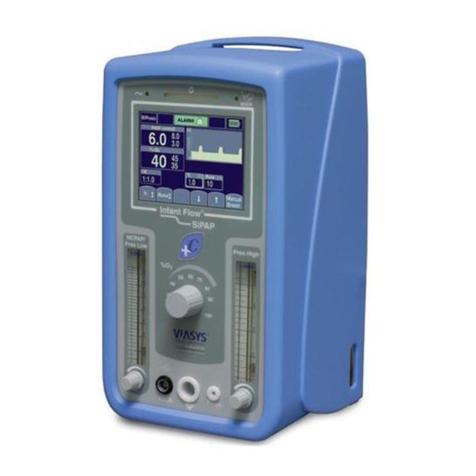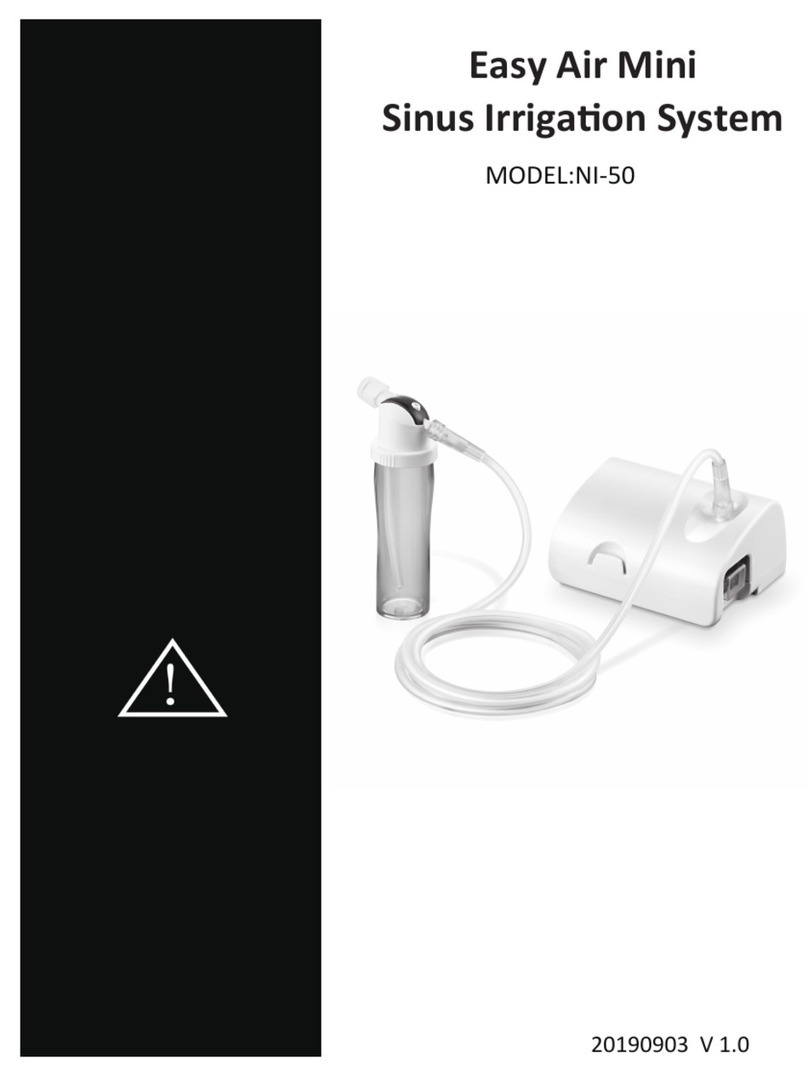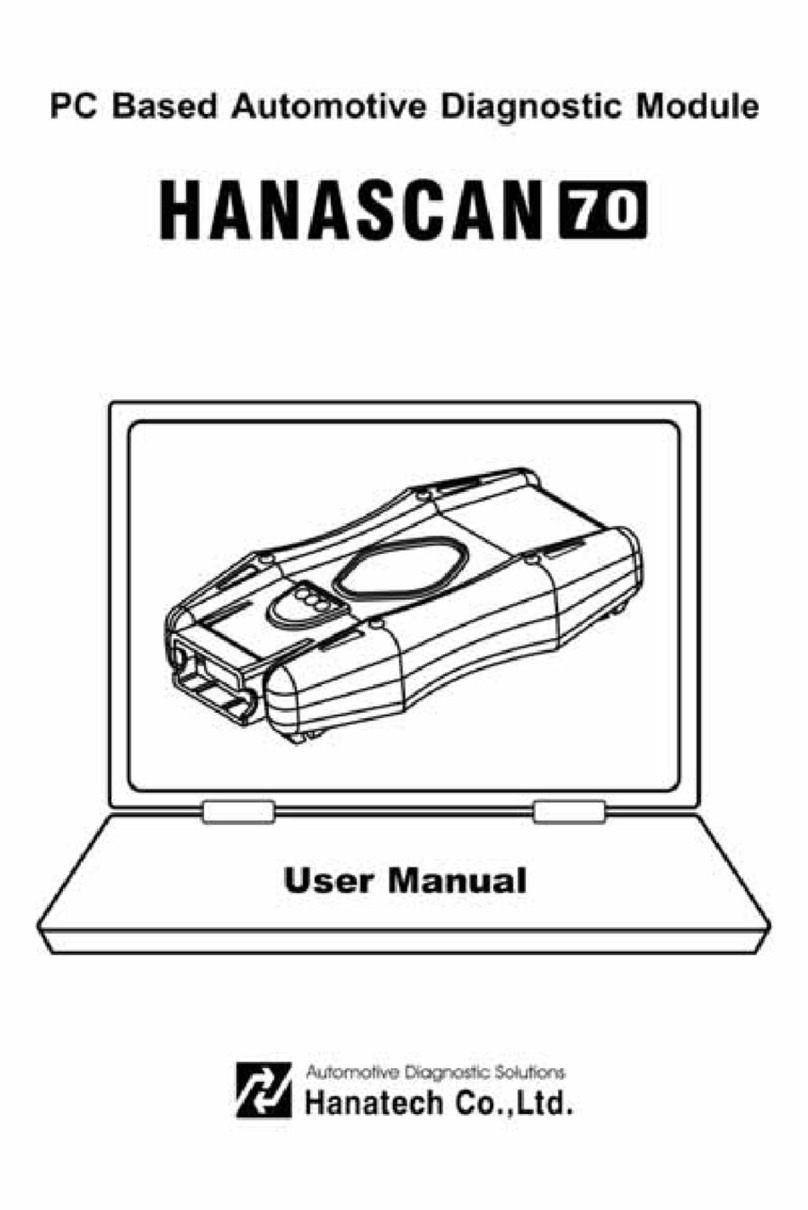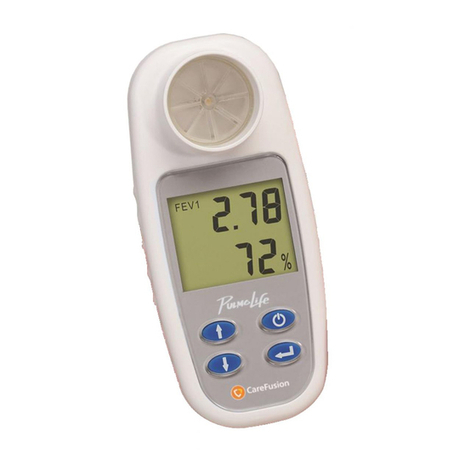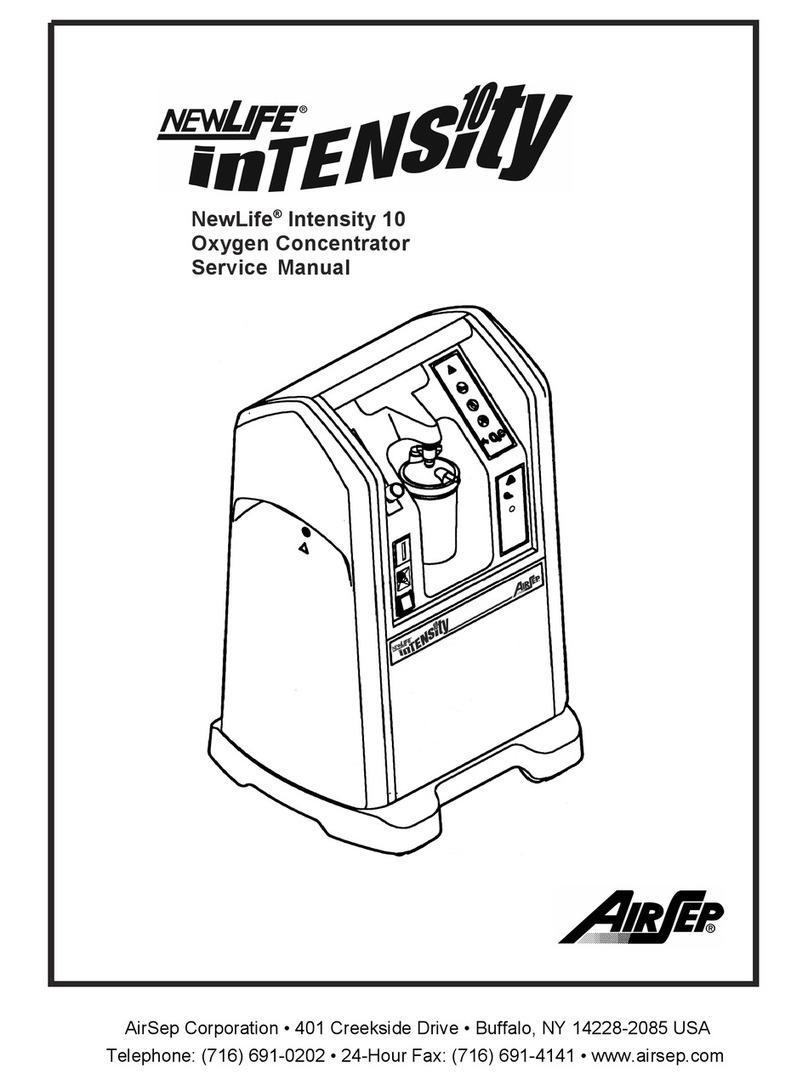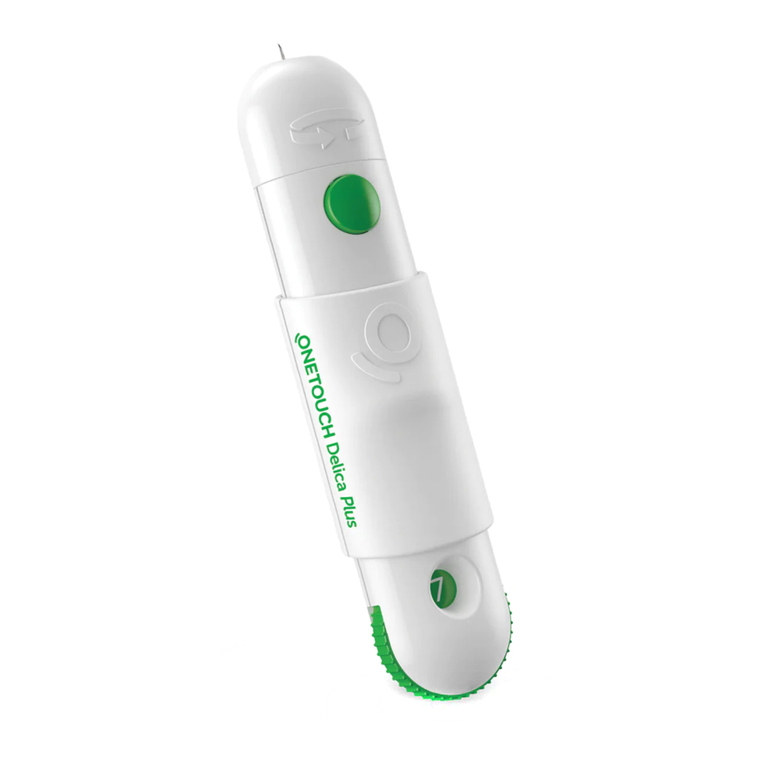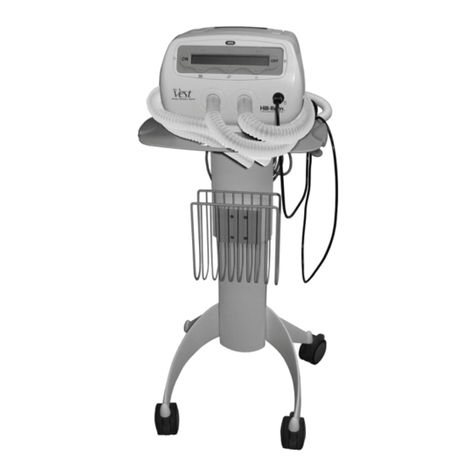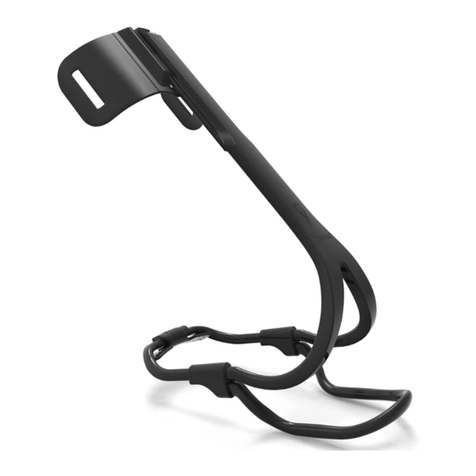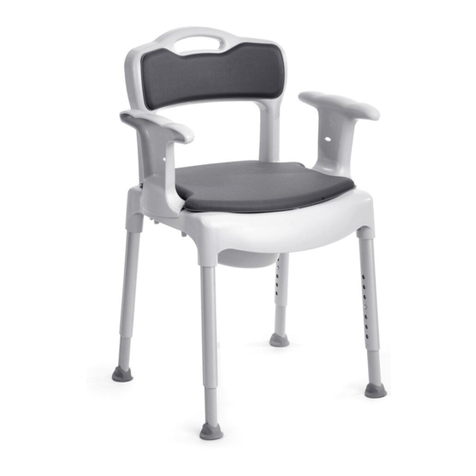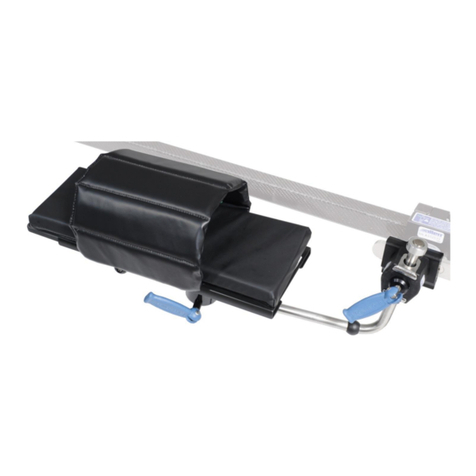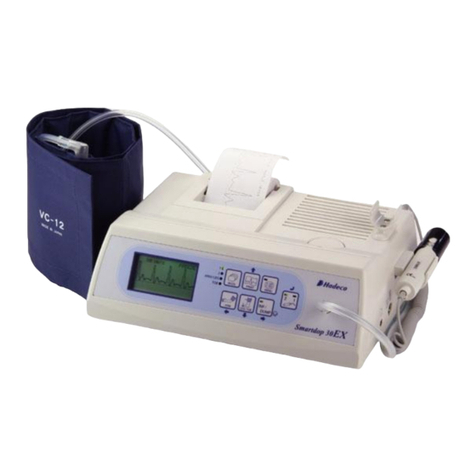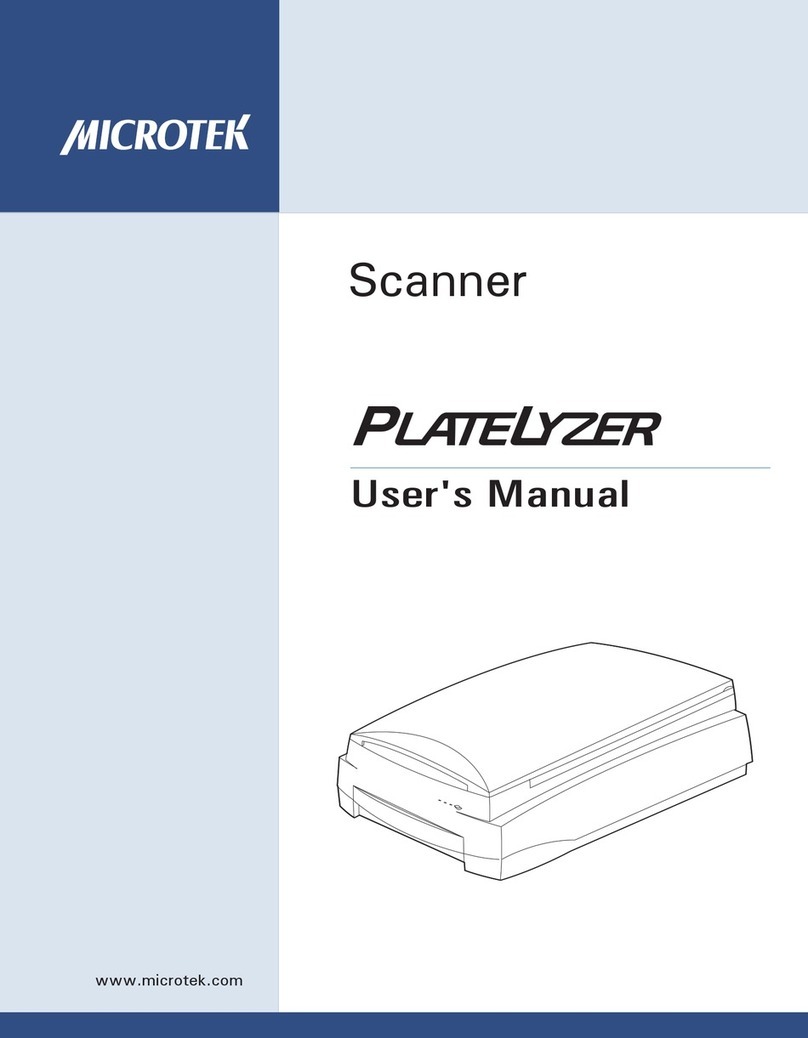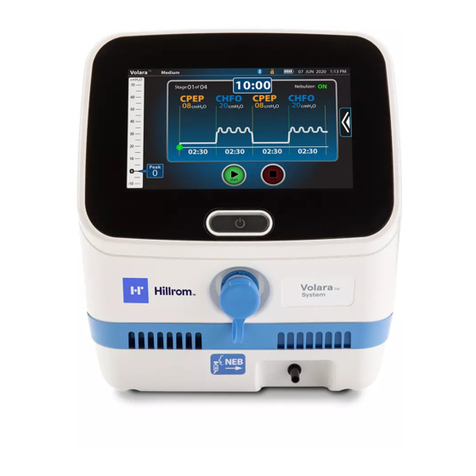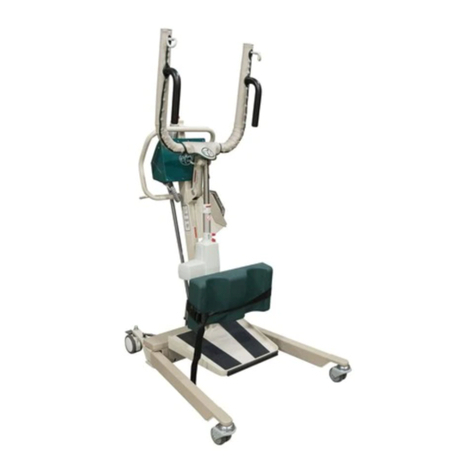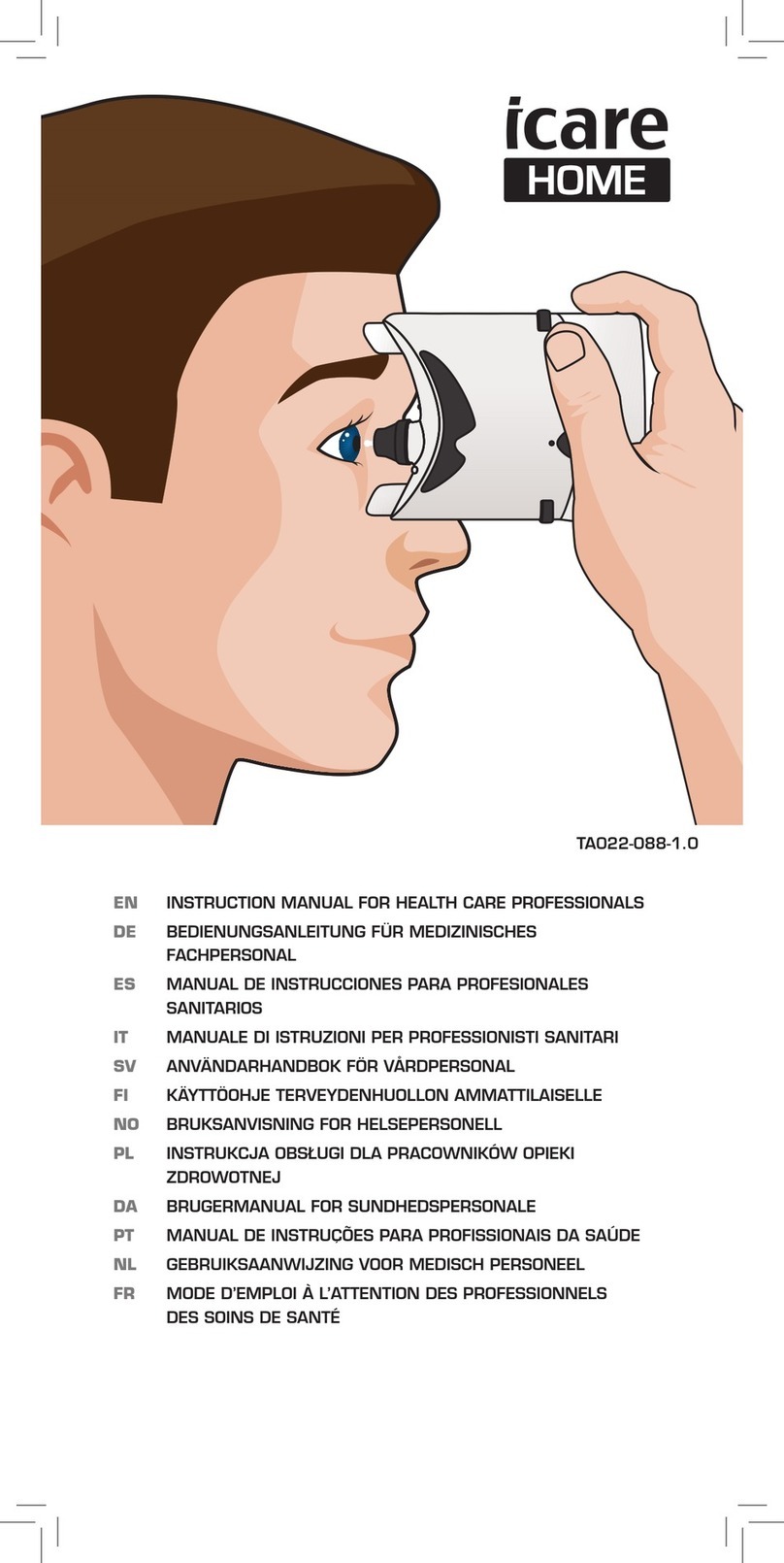Cincinnati Sub-Zero ZP Series Instruction manual

58911 rev B
1/2021
Installation
Operation
Maintenance
Manual
ZP Series

Note: CSZ is continuously upgrading the components used in its equipment.
Consequently, the physical appearance of certain components may vary from
that shown.

INTRODUCTION
This manual has been tailored to match the specific features and options provided
on your Temperature Chamber at the time of original manufacture. The last section
of the manual is the specific information section. This area was developed in an
attempt to better define items on CSZ chambers that are “SPECIFIC” to a customer.
Please refer to this section for warranty, controller PID parameters, and
calibration/verification test data sheets.
Cincinnati Sub-Zero Temperature Chamber:
MODEL NO.
SERIAL NO.
DO NOT USE THIS MANUAL IN AN ATTEMPT TO OPERATE OR MAINTAIN ANY
OTHER MODEL OR SERIAL NUMBER.
PLEASE READ THIS ENTIRE MANUAL BEFORE OPERATING THIS UNIT.

THIS PAGE INTENTIONALLY LEFT BLANK

CHAMBER LABELS AND MEANINGS
i
CHAMBER LABELS AND MEANINGS
Some graphical safety labels may be replaced with textual based safety
labels. Read the entire manual for other safety information that is
applicable to our chamber.
GENERAL DANGER,
CONSULT MANUAL
WEAR EYE PROTECTION
ELECTRICAL SHOCK
TURN OFF AND LOCK OUT
SYSTEM POWER BEFORE
SERVICING
EXPLOSION, ARC FLASH
HAZARD
WEAR PROTECTIVE GLOVES
LOW TEMPERATURE
FORKLIFT RIGHT, DESIGNATES
CHAMBER LIFTING POINTS
HOT SURFACE
FORKLIFT LEFT, DESIGNATES
CHAMBER LIFTING POINTS
KEEP HANDS CLEAR;
PINCH HAZARD
DO NOT OPERATE WITH
PACEMAKER
CONSULT OPERATORS
MANUAL BEFORE
OPERATING
PROTECTIVE CONDUCTOR
TERMINAL

CHAMBER LABELS AND MEANINGS
ii
THIS PAGE INTENTIONALLY LEFT BLANK

TABLE OF CONTENTS
iii
CHAPTER 1
SAFETY PRECAUTIONS-FEATURES
INTRODUCTION ........................................................................................................... 1
GENERAL SAFETY PRECAUTIONS .................................................................................. 1
ELECTROSTATIC DISCHARGE SENSITIVE DEVICES .......................................................... 4
SAFETY FEATURES........................................................................................................ 5
ELECTRICAL CIRCUIT PROTECTION................................................................................ 5
REFRIGERATION SYSTEM PROTECTION ........................................................................ 5
OVER-TEMPERATURE PROTECTION.............................................................................. 5
PRODUCT HIGH LIMIT (IF EQUIPPED) ........................................................................... 5
CHAMBER HIGH LIMIT.................................................................................................. 5
FIGURES AND TABLES
Figure 1-1: Communication Plates ................................................................................. 6
CHAPTER 2
GENERAL DESCRIPTION
SYSTEM DESCRIPTION.................................................................................................. 7
CONTROLLER ............................................................................................................... 7
CHAMBER .................................................................................................................... 7
REFRIGERATION/HEATING COMPONENTS ................................................................... 8
HUMIDITY...................................................................................................................11
PEN RECORDERS (OPTIONAL)......................................................................................17
REDUNDANT HIGH/LOW LIMIT CONTROL (OPTIONAL)................................................17
IEEE-488 SYSTEM (OPTIONAL).....................................................................................17
LN2/CO2 BOOST COOLING SYSTEM (OPTIONAL) .........................................................17
PROGRAMMABLE DOOR LOCK (OPTIONAL) ................................................................18
GN2 PURGE SYSTEM (OPTIONAL)................................................................................18
DRY AIR PURGE (OPTIONAL) .......................................................................................18
LIMITED TEMPERATURE SHEATH HEATER (OPTIONAL)................................................19
GAS MONITOR (OPTIONAL).........................................................................................19
CHAMBER PERFORMANCE ..........................................................................................19
SEQUENCE OF OPERATION..........................................................................................26

TABLE OF CONTENTS
iv
FIGURES AND TABLES
Figure 2-1: Chamber Components Location................................................................................ 9
Figure 2-2: ZPRC Chamber – Side View...................................................................................... 10
Figure 2-3: ZPRC Chamber – Top View ...................................................................................... 10
Figure 2-4: Achievable Humidity Points..................................................................................... 12
Figure 2-5: Optional Recirculating Water/ Demineralizer Filter................................................ 13
Figure 2-6: Humidity Panel Location & Components ................................................................ 14
Figure 2-7: Chamber Interior ..................................................................................................... 16
Figure 2-8: Shelf And Bracket..................................................................................................... 20
Figure 2-9: Shelf In Pulled Out Position ..................................................................................... 20
CHAPTER 3
OPERATING INSTRUCTIONS
START-UP INSTRUCTION SUMMARY (EZT-570S CONTROLLER) ....................................41
PUMPDOWN ..............................................................................................................42
SINGLE SET POINT OPERATION ...................................................................................43
MANUAL EVENT CONTROL .........................................................................................44
PROFILE OPERATION ..................................................................................................44
START-UP INSTRUCTION SUMMARY...........................................................................45
SUMMARY FOR STEP-BY-STEP SET-POINT OPERATION ...............................................45
WATLOW F4 CONTROLLER OUTPUTS..........................................................................46
DRY AIR PURGE ..........................................................................................................48
IEEE 488 - F4 CONTROLLER..........................................................................................49
HIGH/LOW LIMIT CONTROL........................................................................................50
VAISALA HMT337 HUMIDITY AND TEMPERATURE TRANSMITTER ..............................50
PROGRAMMABLE DOOR LOCK (IF EQUIPPED).............................................................51
AIR SUPPLY DAMPER (ZPRC UNITS) ............................................................................52
ATTACHING GLOVES (GLOVE PORT OPTION)...............................................................53
FIGURES AND TABLES
Figure 3-1: CSZ EZT – 570s Controller ......................................................................41
Figure 3-2: Watlow F4 Controller Outputs...............................................................47
Figure 3-3: Dry Air Purge System Components Location (5SCFM Unit) ..................48
Figure 3-4: Controller Panel .....................................................................................51
Figure 3-5: Air Supply Damper .................................................................................52

TABLE OF CONTENTS
v
CHAPTER 4
INSTALLATION
PREPARATION FOR USE ..............................................................................................55
MAIN POWER CONNECTION .......................................................................................57
VOLTAGE CHANGE ON ZP CHAMBERS .........................................................................58
REFRIGERATION SYSTEM PRESSURES ..........................................................................58
WATER COOLED UNITS (OPTIONAL) ............................................................................58
SCROLL COMPRESSORS ONLY .....................................................................................61
HUMIDITY SYSTEM (OPTIONAL) ..................................................................................61
FIGURES AND TABLES
Figure 4-1: Transporting A Chamber............................................................................. 56
Table 4-1: Cascade Water Usage................................................................................... 59
Table 4-2: Tundra Water Usage .................................................................................... 60
Table 4-3: Single Stage Water Usage ............................................................................ 60
Table 4-2: Water Usage (Si Units) ................................................................................. 61

TABLE OF CONTENTS
vi
CHAPTER 5
MAINTENANCE AND Q & A
GENERAL MAINTENANCE........................................................................................63
TEST EQUIPMENT REQUIRED ..................................................................................63
INSPECTION SCHEDULE ...........................................................................................64
VISUAL INSPECTION ................................................................................................68
TROUBLESHOOTING PROCEDURES..........................................................................68
SYSTEM TROUBLESHOOTING ..................................................................................68
SATURATED TEMPERATURE/PRESSURE CHART.......................................................75
PFC REFRIGERANTS .................................................................................................77
RESETTING A CIRCUIT BREAKER ..............................................................................77
HUMIDITY SYSTEM MAINTENANCE.........................................................................78
WATER QUALITY .....................................................................................................80
QUESTIONS & ANSWERS.........................................................................................81
FIGURES AND TABLES
Figure 5-1: Atomizing Nozzle Components .................................................................... 78
Table 5-1: Test Equipment Required .............................................................................. 63
Table 5-2: Inspection Schedule....................................................................................... 64
Table 5-3: Inspection Procedures ................................................................................... 68
Table 5-4: General Troubleshooting Procedures ........................................................... 69
Table 5-4: General Troubleshooting Procedures (Continued) ....................................... 70
Table 5-5: Humidity System Troubleshooting Procedures............................................. 70
Table 5-6: Dry Air Purge Troubleshooting Procedures................................................... 71
Table 5-6: Dry Air Purge Troubleshooting Procedures (Continued) .............................. 72
Table 5-7: LN2 System Troubleshooting Procedures ..................................................... 73
Table 5-8: GN2 Troubleshooting Procedures ................................................................. 73
Table 5-9: Frozen Coil Troubleshooting Procedures ...................................................... 74
Table 5-10: High/Low Limit Control Troubleshooting Procedures................................. 75

TABLE OF CONTENTS
vii
CHAPTER 6
WARRANTY & SHIPPING INFORMATION
HOW TO CONTACT CSZ .............................................................................................. 85
HOW TO OBTAIN REPLACEMENT PARTS / PARTS ORDERING PROCEDURE ................. 85
STANDARD LIMITED EQUIPMENT WARRANTY
*THESE CHAPTERS INCLUDED FOR PRINT MANUALS*
CHAPTER 7
SPECIFIC INFORMATION
CALIBRATION REPORTS
CHAPTER 8
PARTS LISTS
ELECTRICAL BILL OF MATERIALS (IF REQUIRED)
REFRIGERATION BILL OF MATERIALS (IF REQUIRED)
HUMIDITY BILL OF MATERIALS (IF REQUIRED)
DRY AIR PURGE BILL OF MATERIALS (IF REQUIRED)
LN2 BOOST BILL OF MATERIALS (IF REQUIRED)
GN2 PURGE BILL OF MATERIALS (IF REQUIRED)
CHAPTER 9
DRAWINGS
ELECTRICAL SCHEMATIC SYMBOLS
REFRIGERATION SCHEMATIC SYMBOLS
CABINETRY LAYOUT DRAWING (IF REQUIRED)
ELECTRICAL SCHEMATIC (IF REQUIRED)
REFRIGERATION FLOW DIAGRAM (IF REQUIRED)
HUMIDITY FLOW DIAGRAM -WITH OPTIONS (IF REQUIRED)
DRY AIR PURGE FLOW DIAGRAM (IF REQUIRED)
LN2 BOOST FLOW DIAGRAM (IF REQUIRED)
GN2 PURGE DIAGRAM (IF REQUIRED)

TABLE OF CONTENTS
viii
THIS PAGE INTENTIONALLY LEFT BLANK

SAFETY - PRECAUTIONS AND FEATURES
1
INTRODUCTION
Warnings contained in this manual are identified by this symbol. Warnings identify
any conditions or practices that, if not strictly observed, could result in personal
injury or possible loss of life.
Cautions in this manual are identified by this symbol. Cautions identify any
condition or practice that, if not strictly observed, could result in damage to, or
destruction of, the system equipment. Please read all precautions before operating
your unit.
Notes contained in this manual are identified by this symbol. Notes identify items of
importance to proper operation and maintenance.
This instrument has been designed and tested in accordance with IEC Publication
61010-1:2010. Safety Requirements for Electrical Equipment for Measurement,
Control and Laboratory Use and has been supplied in a safe condition. The
instruction documentation contains information and warnings which must be
followed by the user to ensure safe operation and to maintain the instrument in a
safe condition.
GENERAL SAFETY PRECAUTIONS
The following are general safety precautions that are not related to any specific
procedures and therefore do not appear elsewhere in this manual. These are
recommended precautions that must be understood and applied during many
phases of operation and maintenance of the equipment.
IMPORTANT: All OSHA and other applicable local and national codes, regulations,
and guidelines regarding lockout/tagout procedures must be followed. This includes
a lockable disconnect switch.
KEEP AWAY FROM LIVE CIRCUITS
Operating personnel should at all times observe all safety precautions. Do not
replace components or make adjustments inside the equipment with the high
voltage supply turned on. Under certain conditions, dangerous potentials may still
exist when the power switch is in the off position due to charges retained by
capacitors. To avoid injury, always remove power and discharge and ground a
circuit before touching it.
NOTE: Keep unit away from flammable substances.
DO NOT SERVICE OR ADJUST ALONE
No one should reach into an enclosure to service or adjust equipment except in the
presence of someone who is capable of rendering aid.
RESUSCITATION
Personnel working with or near high voltages should be familiar with modern
methods of resuscitation. Such information may be obtained from the Local Red
Cross Agency or other qualified national safety organizations.
WARNING
CAUTION
NOTE

SAFETY - PRECAUTIONS AND FEATURES
2
DO NOT replace components or make adjustments inside the equipment with the main
power supply turned on. Under certain conditions, dangerous potentials may still exist when
the power switch is in the off position due to charges retained by capacitors. To avoid injury,
always remove power and ground a circuit before touching it.
Paint thinners, cleaning solutions and other chemicals or solvents should never be stored in
the vicinity of the unit. High operating temperatures and live electrical circuits could ignite
fumes and cause an explosion.
DO NOT touch refrigeration piping during chamber operation. The refrigeration piping can
become extremely hot or extremely cold, and cause severe burns.
Lockout main power prior to securing. High voltage remains present on main electrical panel
with covers removed.
The chamber door must remain closed during operation. If the door is required to be open,
wear safety goggles to prevent the high velocity airflow from blowing particles or objects
into eyes.
This chamber operates at extreme temperatures. Avoid any personal contact with objects
and surfaces that may be hot or cold to prevent severe burns or frostbite.
The refrigeration unit is a pressurized system and hazards exist which could result in
personal injury. It is therefore recommended that removal and installation of the hermetic
compressor be performed by experienced personnel only. Failure to follow these
instructions may result in serious personal injury.
Gaseous nitrogen/CO2 vent connection must be ducted to the outdoors to prevent
displacement of oxygen around the unit.
DO NOT place items in the chamber that could burn or explode at high temperatures. This
chamber uses open wire heating elements which generate surface temperatures over
1000°F (537°C). This is NOT an explosion-proof chamber.
PRODUCT PROTECTION. Chambers are equipped with high heat limits or safety devices.
These safety devices are installed to protect the chamber from exceeding design limits.
These safety devices remove power ONLY from the chamber heaters and DO NOT remove
power from customer product. Provisions must be made to de-energize the product on test
and the chamber in the event of an over-temperature protection.
All OSHA and other applicable local and national codes, regulations, and guidelines regarding
lockout/tagout procedures must be followed while servicing this unit. This may include a
lockable disconnect switch to remove power from the equipment while servicing.
DO NOT reach into an enclosure to service or adjust equipment except in the presence of
someone who is capable of rendering aid.
Do NOT climb or place top-heavy objects on the top of the chamber.
WARNING
WARNING
WARNING
WARNING
WARNING
WARNING
WARNING
WARNING
WARNING
WARNING
WARNING
WARNING
WARNING

SAFETY - PRECAUTIONS AND FEATURES
3
All loads must be removed from the chamber prior to transport and/or maintenance and
securing. The chamber door must be shut prior to transport or moving.
The installation manual and all notes on the electrical schematic must be followed to ensure
safe installation, operation, and maintenance.
Window frame may become hot during operation.
There are NO provisions for venting fumes.
No operator serviceable parts inside equipment. Refer all servicing to qualified service
personnel. To prevent electric shock, do not open lower enclosure panels.
This product requires a protective earth conductor connection. Any interruption of the
protective conductor inside or outside of the instrument is likely to make the instrument
dangerous. Intentional interruption is prohibited.
Do not position the instrument such that access to the disconnect device is impaired or that
any of the chamber vents are blocked.
If this instrument is not used as specified, the protection provided by the equipment could
be impaired. This instrument must only be used in a normal condition (in which all means of
protection are intact).
For continued protection against fire hazard, qualified service personnel must replace fuses
and circuit breakers with the same type and rating only. The use of other fuses and circuit
breakers is prohibited. Disconnect chamber from electrical supply before changing fuses or
resetting circuit breakers.
Prior to servicing the equipment, the supply power should be disconnected by moving the
main disconnect switch to the OFF (O) position. Failure to do so can result in service
personnel being exposed to accessible hazardous voltages. Follow all local and national
lockout and tagout procedures.
DO NOT put corrosive substances into the chamber. Examples of corrosive substances
include, but are not limited to, Chlorine, Chlorides, and Acids.
DO NOT place items in the chamber which can emit corrosive vapors or substances.
To prevent damage to your test samples and the chamber's compressors, DO NOT exceed
the live load rating of the chamber. (See the General Description Section of this manual for
the live load rating for your unit.)
Running temperature/humidity points outside of the standard range can cause damage to
the refrigeration compressor(s).
Before switching on this equipment, ensure the supply voltage is correct.
WARNING
WARNING
WARNING
WARNING
WARNING
WARNING
WARNING
WARNING
WARNING
WARNING
CAUTION
CAUTION
CAUTION
CAUTION
CAUTION

SAFETY - PRECAUTIONS AND FEATURES
4
ELECTROSTATIC DISCHARGE SENSITIVE DEVICES
This manual contains maintenance procedures for parts and assemblies
sensitive to damage by electrostatic discharge (ESD). Parts or
assemblies are identified as ESD sensitive by the symbol to the left.
The following are general precautions that should be observed when
handling ESD sensitive devices or assemblies:
1. Handling ESD sensitive devices at approved field force protective
work stations.
2. Keep work area free of static generators, such as plastic cups, foam
cushions, and rayon or polyester apparel.
3. Avoid static-producing activities, such as wiping feet and removing or
putting on smocks while in the work area.
4. Use ESD protective equipment, such as grounded work benches,
grounded tools and test equipment, conductive flooring, air ionizers,
personnel ground straps with 1 megohm minimum resistance, and
protective apparel whenever possible.
5. Store and transport ESD sensitive devices in protective bags, tote
boxes, or trays. Use original packaging whenever possible.
6. Remove power and signals before removing or installing ESD
sensitive devices or assemblies.
7. Handle ESD sensitive circuit card assemblies by their shunt bars or
edges. Do not touch parts, terminals, or circuitry. Do not use canned
coolant for fault isolation.

SAFETY - PRECAUTIONS AND FEATURES
5
SAFETY FEATURES
Cincinnati Sub-Zero incorporates many safety features in the design of its
equipment. These safety features provide protection for the equipment, as well
as for operating and maintenance personnel. SEE WARNING.
ELECTRICAL CIRCUIT PROTECTION
1. All power circuits and control circuits are separately protected by circuit
breakers or fuses.
2. Compressors have internal inherent electrical overload protection which
will shut down the compressor in the event of an electrical or thermal
overload.
3. All power to the chamber heaters passes through a non-cycling power
contactor. This contactor is controlled by the chamber over-temperature
limit and an optional High/Low test limit control and is de-energized if
either a chamber is over-temperature, or a test item over/under-
temperature condition exists.
REFRIGERATION SYSTEM PROTECTION
1. The refrigeration systems utilize refrigerants which are non-flammable and
non-explosive.
2. The refrigeration system is equipped with pressure controls. These controls
will shut down the compressor if a high or low pressure condition is
reached. Refer to the Refrigeration Flow Diagram and the Electrical
Schematic for the specific pressure controls on your unit. Contact Cincinnati
Sub Zero with any questions.
OVER-TEMPERATURE PROTECTION
The high temperature cutoff is installed to protect the chamber from exceeding
design limits. This safety device removes power only from the chamber heaters
when an over-temperature condition exists in the chamber. They DO NOT
remove power from the product being tested.
PRODUCT HIGH LIMIT (IF EQUIPPED)
The product high temperature limit can be used to protect the product being
tested and the chamber from overheating. The thermocouple hanging from the
back of the chamber can be attached to the customer product. The product
safety should be checked for proper operation every three (3) months.
CHAMBER HIGH LIMIT
This device is intended for chamber over-temperature protection only. It is
preset to open at the temperature indicated on the Electrical Schematic.
DO NOT BYPASS any of the
safety features provided in
this equipment. Failure to
follow these instructions
could result in serious
personal injury or death.
WARNING
WARNING
DO NOT touch refrigeration
lines while the unit is in
operation. Lines can become
extremely hot or very cold
and can cause severe burns.
Cincinnati Sub-Zero
chambers are equipped
with high heat limits, or
safety devices. These safety
devices are installed to
protect the unit from
exceeding design limits.
These safety devices
remove power ONLY from
the chamber heaters and
DO NOT remove power
from your product.
Provisions must be made to
de-energize the product
under test and the chamber
in the event of an over-
temperature condition.
WARNING
The chamber high limit and
other latching thermostats
and thermal cut outs can
only be reset by properly
trained service personnel.
Only access the chamber
sub panel or remove any
side rear service panels if
you are a qualified service
personnel.
WARNING

SAFETY - PRECAUTIONS AND FEATURES
6
Figure 1-1: Communication Plates
Note: CSZ is continuously upgrading the components used in its
equipment. Consequently, the physical appearance of certain
components may vary from that shown.
Connection for event relay(s). Do not connect 115-volt
power to these connections. Customer events should only
be connected to a 24VDC/AC source. See EZT-570S User
Manual for exact specifications.
NOTE
COMMUNICATION
CONNECTIONS
CONNECTION
FOR EVENT RELAY

GENERAL DESCRIPTION
7
CHAPTER 2: GENERAL DESCRIPTION
SYSTEM DESCRIPTION
The ZP-Series Temperature chambers are pre-engineered chambers designed to
provide an environment with specific temperature (humidity) conditions. The
standard ZP model is composed of the following: 1. Controller, 2. Chamber, 3.
Refrigeration/ Heating components. Optional equipment includes, but is not
limited to: 4. Humidity, 5. Pen Recorders, 6. High/Low Limit, 7. IEEE-488 Serial
Interface, 8. Boost Cooling System, 9. GN2 Purge, 10. Dry Air Purge, 11. Limited
Temperature Sheath Heaters.
The chambers have a standard range of -94°F to +375°F (-70°C to +190°C)
cascade, -50°F to +375°F (-45°C to +190°C) Tundra, and -30°F to +375°F (-34°C
to +190°C) single stage which provide both heating and cooling as required.
Chambers with optional humidity are designed to provide a minimum of 10%
and a maximum of 98% relative humidity, as limited by a 45°F (7°C) dewpoint
and a 185°F (85°C) maximum dry bulb temperature. Refer to Figure 2 for
Achievable Humidity Points. The chambers are designed to operate in a
commercial environment, i.e. temperature of +75°F +/- 10°F (+23°C +/- 6°C),
maximum dew point of 55°F (12.8°C), and an altitude of 7,000 ft. (2133.6M).
Refer to the specifications at the end of this section for additional information.
CONTROLLER
The standard controller is composed of a CSZ EZT-570S Controller, a High/Low
limit, and communications electronics. Detailed operating instructions for the
controller are found in the controller user’s manuals on the digital media that
accompanied the chamber. Other optional controllers available include the
Watlow F4. See Operating Instructions in Chapter 4 for more information
regarding chamber controllers.
CHAMBER
A. Chamber Interior
The chamber interior consists of the front workspace and the rear component
area, separated by a stainless-steel plenum cover. A probe bracket is behind
the grille in the upper left corner of the plenum. The bracket contains the
probes for the controller, recorder (if required), and RH sensor (if humidity
option is installed). The area behind the plenum cover contains the
refrigeration evaporator coil, heater limit thermocouple, evaporator fan(s),
humidification inlet (if humidity option is installed), auxiliary cooling nozzle (if
auxiliary cooling option is installed), and the dehumidification coil (if humidity
option is installed). These items may only be accessed by removal of the plenum
cover by properly trained service personnel.
B. Chamber Exterior
Fiberglass insulation is used with a high temperature binder for temperatures
up to 500°F (260°C). The cabinet is constructed with a minimum of mechanical
contact between the liner and the exterior to reduce conductive heat losses and
minimize condensation on the exterior cabinet.
Condensation on exterior
surfaces is normal when
operating at cold
temperatures for an
extended period of time.
NOTE

GENERAL DESCRIPTION
8
A multiple-pane window assembly in the door of the chamber allows
viewing of the chamber interior during operation. The window is
constructed of tempered glass panes with a heater harness to assure frost-
free viewing during low temperature chamber operation. Under certain
ambient conditions, it may be normal to see some condensation around
the outer window frame area during low temperature operation.
REFRIGERATION/HEATING COMPONENTS
A. Refrigeration
ZP-Series chambers use one of three types of mechanical refrigeration
systems: single stage, Tundra®, and cascade. A single stage system is used
when the chamber’s ultimate low temperature is -30°F (-34°C) or higher.
The Tundra system is used when the chambers ultimate low temperature is
-50°F (-45°C) or higher. A cascade system is used when the chamber’s
ultimate low temperature is -94°F (-70°C). The single stage system uses
refrigerant R-404A. The cascade system uses refrigerant R-404A in System
#1 and R-508B/R-23 in System #2. The Tundra System uses refrigerant R-
410A.
The refrigeration system can either be air cooled or water cooled
depending on the model of chamber. Standard ZP-Series chambers above
3.5 HP are air cooled.
Chambers with compressors which are 10 HP (having nominally approx.
12kW of capacity with R-404A refrigerant at 60 Hz operation) and larger
are water cooled.
All refrigeration components are selected to ensure safe, reliable, and
balanced operation. The components may be purchased from the CSZ
Service Department or a local refrigeration wholesaler.
B. Heating
Open-coil nichrome heating elements are standard on all systems. The
heaters are mounted in porcelain insulators attached to stainless steel
frames. The heaters are located behind the rear plenum and do not
radiate directly into the test space.
Limited temperature sheath heaters are an option for chambers that may
contain flammable vapors. See the last section of this chapter for more
information.
This manual suits for next models
5
Table of contents
Other Cincinnati Sub-Zero Medical Equipment manuals
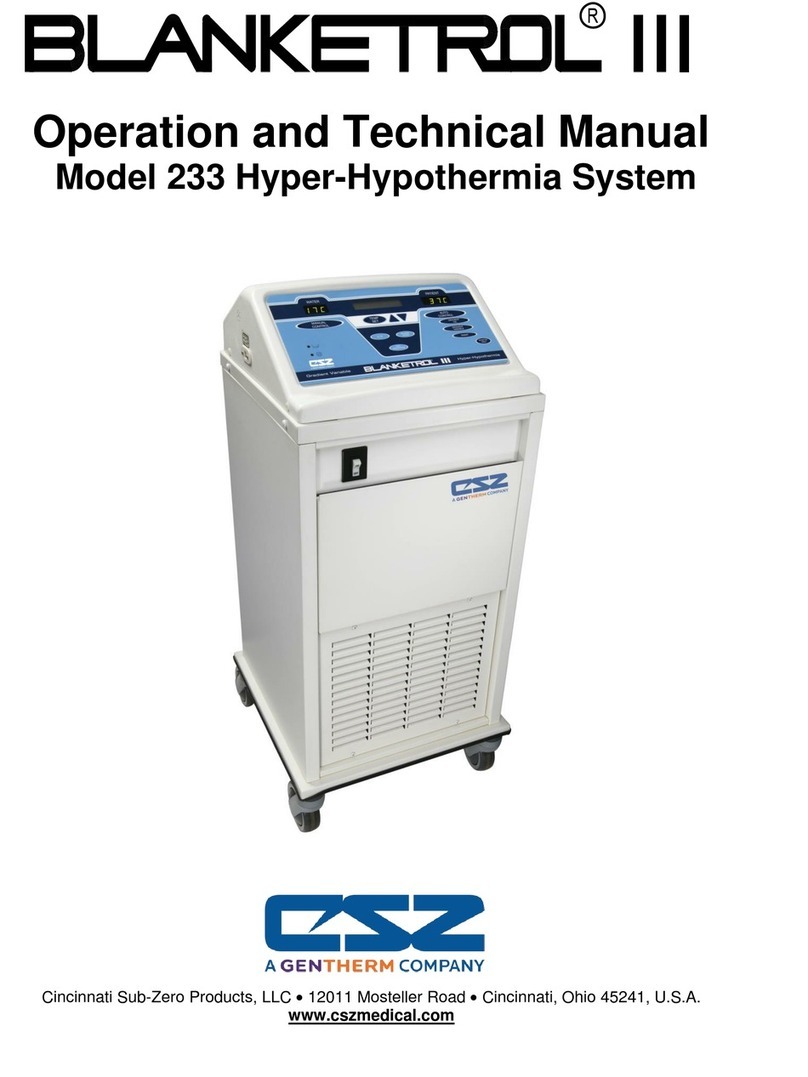
Cincinnati Sub-Zero
Cincinnati Sub-Zero BLANKETROL III 233 User manual
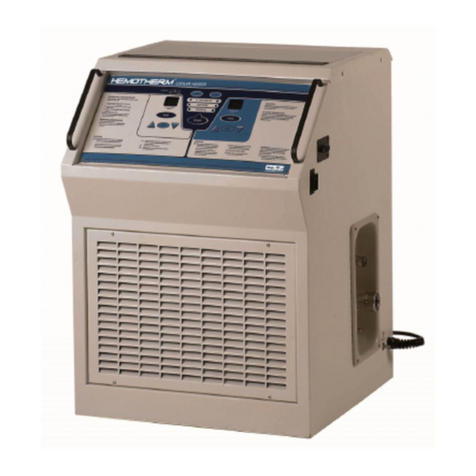
Cincinnati Sub-Zero
Cincinnati Sub-Zero HEMOTHERM 400CE User manual
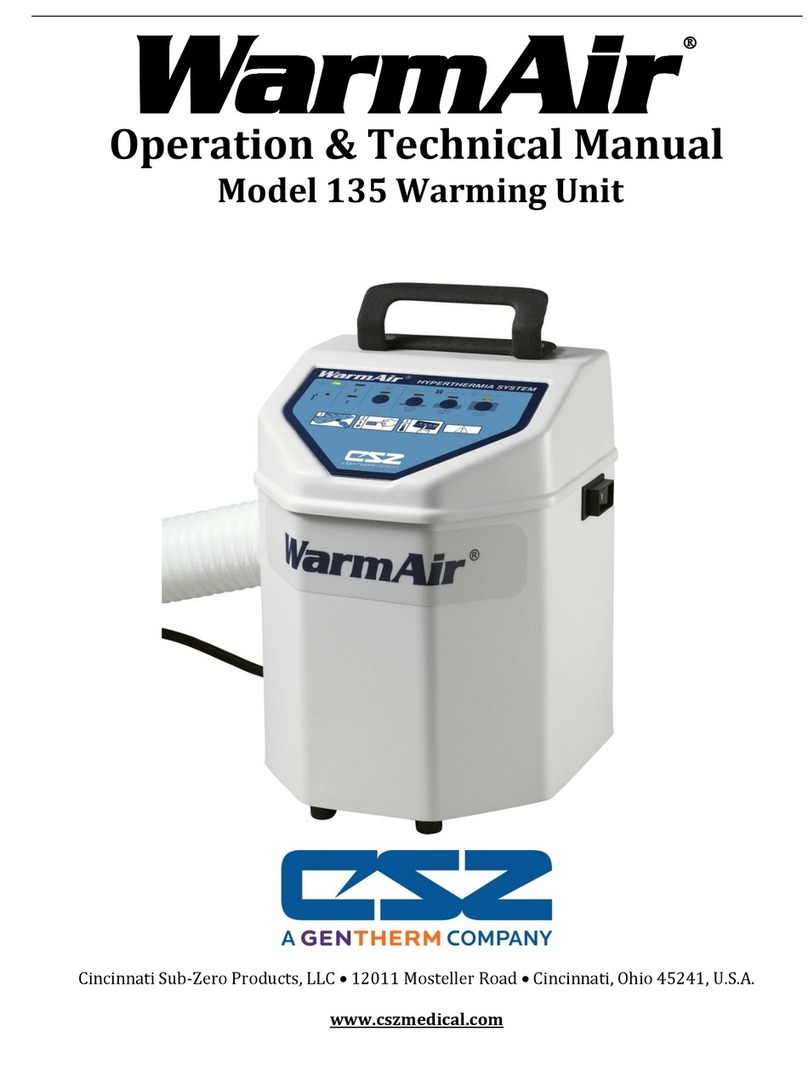
Cincinnati Sub-Zero
Cincinnati Sub-Zero WarmAir 135 User manual
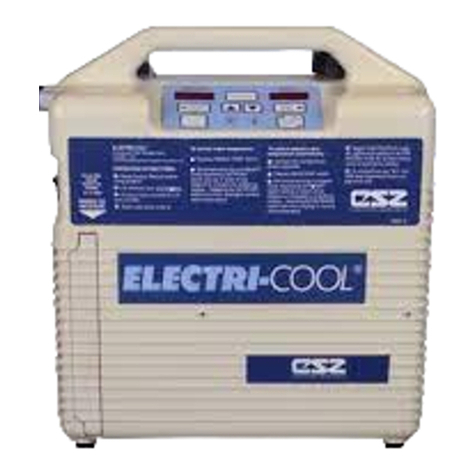
Cincinnati Sub-Zero
Cincinnati Sub-Zero ELECTRI-COOL 757 User manual
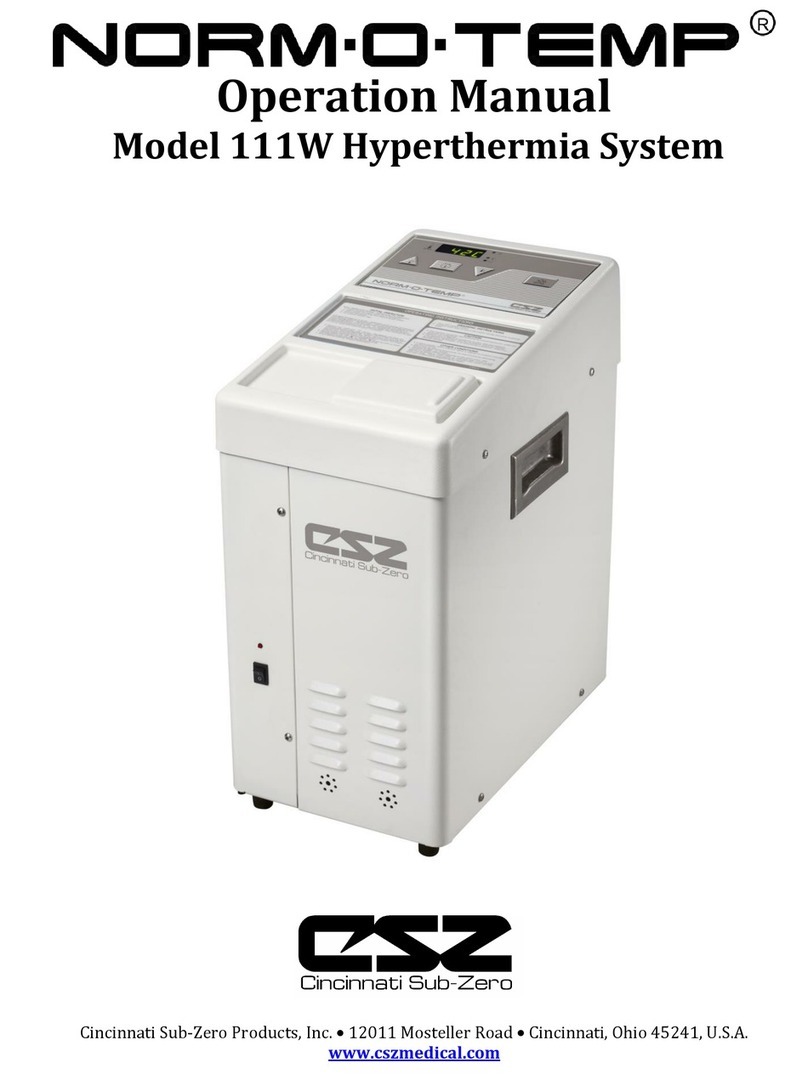
Cincinnati Sub-Zero
Cincinnati Sub-Zero NORM-O-TEMP Installation manual
